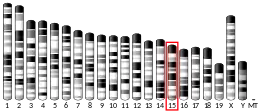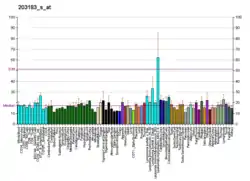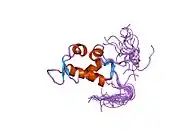| SMARCD1 | |||||||||||||||||||||||||||||||||||||||||||||||||||
|---|---|---|---|---|---|---|---|---|---|---|---|---|---|---|---|---|---|---|---|---|---|---|---|---|---|---|---|---|---|---|---|---|---|---|---|---|---|---|---|---|---|---|---|---|---|---|---|---|---|---|---|
 | |||||||||||||||||||||||||||||||||||||||||||||||||||
| |||||||||||||||||||||||||||||||||||||||||||||||||||
| Identifiers | |||||||||||||||||||||||||||||||||||||||||||||||||||
| Aliases | SMARCD1, BAF60A, CRACD1, Rsc6p, SWI/SNF related, matrix associated, actin dependent regulator of chromatin, subfamily d, member 1, CSS11 | ||||||||||||||||||||||||||||||||||||||||||||||||||
| External IDs | OMIM: 601735 MGI: 1933623 HomoloGene: 20670 GeneCards: SMARCD1 | ||||||||||||||||||||||||||||||||||||||||||||||||||
| |||||||||||||||||||||||||||||||||||||||||||||||||||
| |||||||||||||||||||||||||||||||||||||||||||||||||||
| |||||||||||||||||||||||||||||||||||||||||||||||||||
| |||||||||||||||||||||||||||||||||||||||||||||||||||
| |||||||||||||||||||||||||||||||||||||||||||||||||||
| Wikidata | |||||||||||||||||||||||||||||||||||||||||||||||||||
| |||||||||||||||||||||||||||||||||||||||||||||||||||
SWI/SNF-related matrix-associated actin-dependent regulator of chromatin subfamily D member 1 is a protein that in humans is encoded by the SMARCD1 gene.[5][6][7][8]
The protein encoded by this gene is a member of the SWI/SNF family of proteins, whose members display helicase and ATPase activities and which are thought to regulate transcription of certain genes by altering the chromatin structure around those genes. The encoded protein is part of the large ATP-dependent chromatin remodeling complex SNF/SWI and has sequence similarity to the yeast Swp73 protein. Two transcript variants encoding different isoforms have been found for this gene.[8]
Interactions
SMARCD1 has been shown to interact with Glucocorticoid receptor.[7]
References
- 1 2 3 GRCh38: Ensembl release 89: ENSG00000066117 - Ensembl, May 2017
- 1 2 3 GRCm38: Ensembl release 89: ENSMUSG00000023018 - Ensembl, May 2017
- ↑ "Human PubMed Reference:". National Center for Biotechnology Information, U.S. National Library of Medicine.
- ↑ "Mouse PubMed Reference:". National Center for Biotechnology Information, U.S. National Library of Medicine.
- ↑ Wang W, Xue Y, Zhou S, Kuo A, Cairns BR, Crabtree GR (Nov 1996). "Diversity and specialization of mammalian SWI/SNF complexes". Genes Dev. 10 (17): 2117–30. doi:10.1101/gad.10.17.2117. PMID 8804307.
- ↑ Ring HZ, Vameghi-Meyers V, Wang W, Crabtree GR, Francke U (Sep 1998). "Five SWI/SNF-related, matrix-associated, actin-dependent regulator of chromatin (SMARC) genes are dispersed in the human genome". Genomics. 51 (1): 140–3. doi:10.1006/geno.1998.5343. PMID 9693044.
- 1 2 Hsiao PW, Fryer CJ, Trotter KW, Wang W, Archer TK (Aug 2003). "BAF60a mediates critical interactions between nuclear receptors and the BRG1 chromatin-remodeling complex for transactivation". Mol Cell Biol. 23 (17): 6210–20. doi:10.1128/MCB.23.17.6210-6220.2003. PMC 180928. PMID 12917342.
- 1 2 "Entrez Gene: SMARCD1 SWI/SNF related, matrix associated, actin dependent regulator of chromatin, subfamily d, member 1".
Further reading
- Hillier LD, Lennon G, Becker M, et al. (1997). "Generation and analysis of 280,000 human expressed sequence tags". Genome Res. 6 (9): 807–28. doi:10.1101/gr.6.9.807. PMID 8889549.
- Wang W, Côté J, Xue Y, et al. (1996). "Purification and biochemical heterogeneity of the mammalian SWI-SNF complex". EMBO J. 15 (19): 5370–82. doi:10.1002/j.1460-2075.1996.tb00921.x. PMC 452280. PMID 8895581.
- Cho H, Orphanides G, Sun X, et al. (1998). "A human RNA polymerase II complex containing factors that modify chromatin structure". Mol. Cell. Biol. 18 (9): 5355–63. doi:10.1128/MCB.18.9.5355. PMC 109120. PMID 9710619.
- O'Neill D, Yang J, Erdjument-Bromage H, et al. (1999). "Tissue-specific and developmental stage-specific DNA binding by a mammalian SWI/SNF complex associated with human fetal-to-adult globin gene switching". Proc. Natl. Acad. Sci. U.S.A. 96 (2): 349–54. Bibcode:1999PNAS...96..349O. doi:10.1073/pnas.96.2.349. PMC 15139. PMID 9892636.
- Phelan ML, Sif S, Narlikar GJ, Kingston RE (1999). "Reconstitution of a core chromatin remodeling complex from SWI/SNF subunits". Mol. Cell. 3 (2): 247–53. doi:10.1016/S1097-2765(00)80315-9. PMID 10078207.
- Ito T, Yamauchi M, Nishina M, et al. (2001). "Identification of SWI.SNF complex subunit BAF60a as a determinant of the transactivation potential of Fos/Jun dimers". J. Biol. Chem. 276 (4): 2852–7. doi:10.1074/jbc.M009633200. PMID 11053448.
- Xue Y, Canman JC, Lee CS, et al. (2001). "The human SWI/SNF-B chromatin-remodeling complex is related to yeast rsc and localizes at kinetochores of mitotic chromosomes". Proc. Natl. Acad. Sci. U.S.A. 97 (24): 13015–20. Bibcode:2000PNAS...9713015X. doi:10.1073/pnas.240208597. PMC 27170. PMID 11078522.
- Kato H, Tjernberg A, Zhang W, et al. (2002). "SYT associates with human SNF/SWI complexes and the C-terminal region of its fusion partner SSX1 targets histones". J. Biol. Chem. 277 (7): 5498–505. doi:10.1074/jbc.M108702200. hdl:2066/170683. PMID 11734557.
- Strausberg RL, Feingold EA, Grouse LH, et al. (2003). "Generation and initial analysis of more than 15,000 full-length human and mouse cDNA sequences". Proc. Natl. Acad. Sci. U.S.A. 99 (26): 16899–903. Bibcode:2002PNAS...9916899M. doi:10.1073/pnas.242603899. PMC 139241. PMID 12477932.
- Nie Z, Yan Z, Chen EH, et al. (2003). "Novel SWI/SNF chromatin-remodeling complexes contain a mixed-lineage leukemia chromosomal translocation partner". Mol. Cell. Biol. 23 (8): 2942–52. doi:10.1128/MCB.23.8.2942-2952.2003. PMC 152562. PMID 12665591.
- Chien CY, Liu WK, Chou CK, Su JY (2003). "The A20-binding protein ABIN-2 exerts unexpected function in mediating transcriptional coactivation". FEBS Lett. 543 (1–3): 55–60. doi:10.1016/S0014-5793(03)00401-0. PMID 12753905. S2CID 31400521.
- Kitagawa H, Fujiki R, Yoshimura K, et al. (2003). "The chromatin-remodeling complex WINAC targets a nuclear receptor to promoters and is impaired in Williams syndrome". Cell. 113 (7): 905–17. doi:10.1016/S0092-8674(03)00436-7. PMID 12837248.
- Brandenberger R, Wei H, Zhang S, et al. (2005). "Transcriptome characterization elucidates signaling networks that control human ES cell growth and differentiation". Nat. Biotechnol. 22 (6): 707–16. doi:10.1038/nbt971. PMID 15146197. S2CID 27764390.
- Gerhard DS, Wagner L, Feingold EA, et al. (2004). "The status, quality, and expansion of the NIH full-length cDNA project: the Mammalian Gene Collection (MGC)". Genome Res. 14 (10B): 2121–7. doi:10.1101/gr.2596504. PMC 528928. PMID 15489334.
- Rual JF, Venkatesan K, Hao T, et al. (2005). "Towards a proteome-scale map of the human protein-protein interaction network". Nature. 437 (7062): 1173–8. Bibcode:2005Natur.437.1173R. doi:10.1038/nature04209. PMID 16189514. S2CID 4427026.
- Kimura K, Wakamatsu A, Suzuki Y, et al. (2006). "Diversification of transcriptional modulation: large-scale identification and characterization of putative alternative promoters of human genes". Genome Res. 16 (1): 55–65. doi:10.1101/gr.4039406. PMC 1356129. PMID 16344560.
- Assmann EM, Alborghetti MR, Camargo ME, Kobarg J (2006). "FEZ1 dimerization and interaction with transcription regulatory proteins involves its coiled-coil region". J. Biol. Chem. 281 (15): 9869–81. doi:10.1074/jbc.M513280200. PMID 16484223.
This article is issued from Wikipedia. The text is licensed under Creative Commons - Attribution - Sharealike. Additional terms may apply for the media files.






